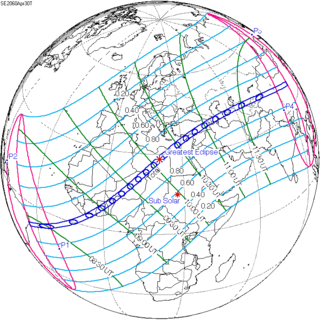| Solar eclipse of April 30, 2060 | |
|---|---|
| Type of eclipse | |
| Nature | Total |
| Gamma | 0.2422 |
| Magnitude | 1.066 |
| Maximum eclipse | |
| Duration | 315 s (5 min 15 s) |
| Coordinates | 28°00′N 20°54′E / 28°N 20.9°E |
| Max. width of band | 222 km (138 mi) |
| Times (UTC) | |
| Greatest eclipse | 10:10:00 |
| References | |
| Saros | 139 (32 of 71) |
| Catalog # (SE5000) | 9642 |
A total solar eclipse will occur at the Moon's ascending node of orbit on Friday, April 30, 2060,[1] with a magnitude of 1.066. A solar eclipse occurs when the Moon passes between Earth and the Sun, thereby totally or partly obscuring the image of the Sun for a viewer on Earth. A total solar eclipse occurs when the Moon's apparent diameter is larger than the Sun's, blocking all direct sunlight, turning day into darkness. Totality occurs in a narrow path across Earth's surface, with the partial solar eclipse visible over a surrounding region thousands of kilometres wide. Occurring about 18 hours after perigee (on April 29, 2060, at 15:50 UTC), the Moon's apparent diameter will be larger.[2]
The path of totality will be visible from parts of Côte d'Ivoire, Ghana, Togo, Benin, eastern Burkina Faso, northwestern Nigeria, Niger, northwestern Chad, Libya, northwestern Egypt, Cyprus, Turkey, northwestern Syria, Armenia, Azerbaijan, northwestern Iran, Turkmenistan, Uzbekistan, southern Kazakhstan, Kyrgyzstan, and China. A partial solar eclipse will also be visible for much of eastern Brazil, Africa, Europe, and Asia.
- ^ "April 30, 2060 Total Solar Eclipse". timeanddate. Retrieved 17 August 2024.
- ^ "Moon Distances for London, United Kingdom, England". timeanddate. Retrieved 17 August 2024.
